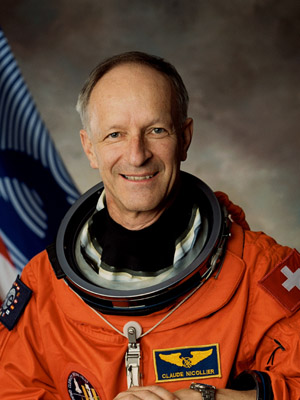December 2009
Claude Nicollier will be on the board of directors of the future SmartFish AG: "I support the SmartFish project because the conventional designs have been widely exploited so far, mostly with success, but the time has come to be creative and try other approaches using new technologies and different, low drag aerodynamic shapes - this is exactly what the SmartFish team is doing".
Claude Nicollier has been for nearly 30 years a European Space Agency (ESA) astronaut of Swiss nationality. He graduated from the University of Lausanne in 1970 (Bachelor of Science in physics) and the University of Geneva in 1975 (Master of Science in astrophysics). He also graduated as a Swiss Air Force pilot in 1966, an airline pilot in 1974 (flew DC-9s for Swissair 1974-1976), and a test pilot in 1988 (Empire Test Pilot's School, Boscombe Down, United Kingdom).


He was a member of the first group of ESA astronauts selected in 1978. He joined Group 9 of NASA astronauts in 1980 for Space Shuttle training at the Johnson Space Center, Houston, Texas, where he has been stationed until September 2005. His technical assignments in Houston have included Space Shuttle flight software verification in the Shuttle Avionics Integration Laboratory (SAIL), development of Tethered Satellite System (TSS) retrieval techniques, Remote Manipulator System (RMS) and International Space Station (ISS) robotics support. From 1996 to 1998, he was Head of the Astronaut Office Robotics Branch. From 2000 on, he was a member of the Astronaut Office EVA (Extravehicular Activity) Branch, while maintaining a position as Lead ESA astronaut in Houston. During his assignment in Houston, he also maintained an active duty status within the Swiss Air Force with a rank as Captain, flying on Hawker Hunter, Northrop F-5E "Tiger", and Pilatus PC-9 aircraft until end of 2004. He has logged more than 6000 flight hours, 3500 of which in jet aircraft.
He retired from ESA in early 2007, and is currently professor at the Swiss Federal Institute of Technology in Lausanne or EPFL (Ecole Polytechnique Fédérale de Lausanne) where he teaches a course on “Space Technology and Operations”, and provides assistance to students on various space related projects. From the spring semester of 2009, this course is also transmitted to students at the Swiss Federal Institute of Technology in Zürich (ETHZ). He is also involved in the “Solar Impulse” solar powered aircraft program as Head of flight test operations. This project was launched by Bertrand Piccard and André Borschberg and has as objective to fly round the world in several legs on solar power only, with one pilot on board.
He has been a crewmember on four Space Shuttle flights, STS-46 in 1992 (EURECA deployment and first test of TSS), STS-61 in 1993 (first servicing mission of the Hubble Space Telescope), STS-75 in 1996 (second flight of TSS, and USMP-3 microgravity investigations), and STS-103 in 1999 (third servicing mission of the Hubble Space Telescope). He has logged more than 1000 hours in space, including a spacewalk of 8 hours 10 minutes duration to install new equipment on the Hubble Space Telescope on STS-103. He is a recipient of Honorary Doctorates from EPFL, and the Universities of Geneva and Basel.
